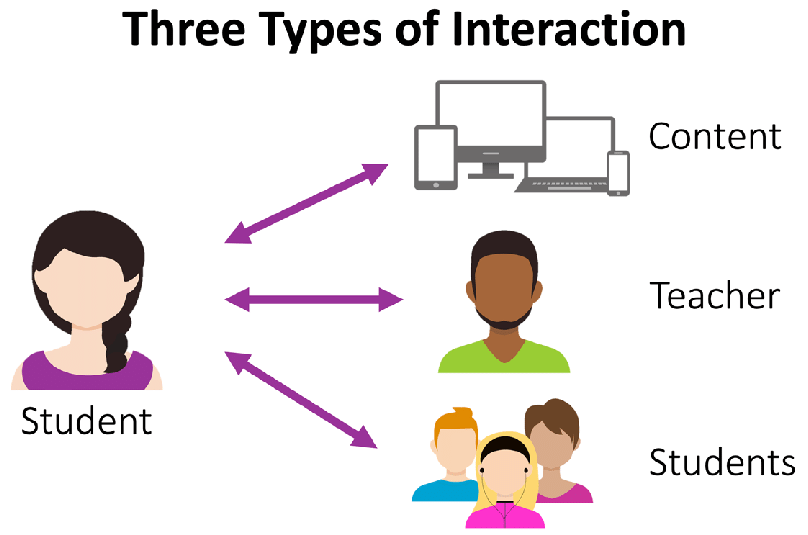Unit 3: Learning Activities for HyFlex Courses

Build connection using learning activities
Choosing learning activities for a HyFlex course might feel like a daunting task because you need to consider the needs of all participatory modes. You might be concerned about how to plan for activities when the proportion of students attending in any one modality may shift from week to week. You may also be asking yourself how to encourage participation from students and interaction across modalities.
Above all else, successful learning environments establish community.
Moore (1989) described three types of learning interactions essential for a good learning experience: (1) student to content, (2) student to teacher, and (3) student to student. By providing opportunities for students to interact with you and one another through interactive and meaningful learning activities, you can help to build a strong community for learning.

In this unit, you will explore how to intentionally select learning activities to support all three types of interactions and contribute to an engaging learning environment.
Strategies for building connections
When planning a HyFlex lesson that promotes a community of learners, consider the following suggestions so that all modalities can interact with one another and with the educator.
Discussion Forums
If your goal is to connect synchronous and asynchronous learners, you will need to be thoughtful about when each group shares their responses in discussion forums. Because of this, you may want to consider flexible due dates. If asynchronous participants post ahead of the synchronous class period, you can pull those responses into the synchronous discussion. If the synchronous participants contribute first, the asynchronous participants may have a richer context to support their own responses.
Acknowledging the contributions of asynchronous participants is essential to maintaining a strong learning community. There is no one right way to do this; as mentioned in Module 1, “asynchronous” does not mean self-paced. When the goal of an activity is to foster collaboration, due dates and timelines will need to be shared across the various learning modalities.
Communicating Expectations
It is helpful if you communicate your expectations clearly and have a regular cadence to activities in your course. Having a predictable schedule for when learning activities open and close can help support students across all three learning modalities.
In addition, telling students the approximate time it may take them to complete the learning objectives for the unit can help students plan appropriately.
Using Technology
Some learning activities can be enhanced with the use of technology tools. We recommend that you explore the capabilities of your Learning Management System (LMS) before adding external tools and that you limit the number of tools in your course. Using too many different tools may overwhelm students who need to learn them for the first time.
Likewise, technology tools should only be added to your course when they serve a clear pedagogical need and enhance student learning. If you have a teaching and learning support centre at your institution, consider reaching out to them for suggested technology tools. Adopting a tool that has already been vetted by your institution will make it easier for you to acquire help and training. In Module 3, you will learn more about technology tools to support HyFlex instruction.
Encouraging Participation
You may also be wondering how to encourage participation from students. Adding grades to learning activities is one strategy to encourage participation, but it comes with some clear drawbacks. Be thoughtful about your marking load and the goal of the activity. While it might be reasonable to assign a single point for completion of an activity, it probably isn’t reasonable to have a complex rubric every time.
After all, learning activities are meant to support graded activities by allowing students to practice their skills and collaborate with others. When you help students to see the relevance of the learning activity, their motivation to participate is often strengthened.
 Activity
Activity
Before you plan your learning activities, reflect on the following questions:
- What are your lesson objectives?
- What type of activity will support your students to reach the instructional goals?
- What type of interaction (student-content, student-teacher, student-student) does the learning activity support?
- How will you help your students see the relevance of the activity to their learning journey?
- Do you need to build in scaffolding activities to help your students develop higher-level skills connected to the subject matter?
- How will you debrief the learning activity to support students to make meaning from the experience?
Learning Activities for HyFlex
The following section describes 34 different learning activities that are effective in a HyFlex environment and that can be used in many ways. In an effort to minimize your planning time but maximize the impact, try the lowest effort solution that will work in all three modalities.
You may have alternative ideas about how to deliver these activities. Draw on your experiences, expertise, and tools to make these ideas work for you, your students, and your context.
 Activity
Activity
As you explore the activities below, ask yourself the following questions:
- Which activities have I used before outside of a HyFlex environment?
- Which activities seem most suitable for my course, students, and skill-set?
- What resources will I need to implement these activities?
- Who can I contact for support as I adopt new practices?
Breakdown of Learning Activities within Bloom’s Taxonomy [PDF]
For an accessible-friendly version of the information above, download the HyFlex Learning Activity How-To Guide [.docx]
Unit Summary
In this unit, we discussed the importance of building community within the HyFlex environment. You explored strategies on how to do so, such as using discussion forums, communicating expectations, using technology, and generating participation.
You then explored 34 active learning activities and how you can modify them according to modality.

